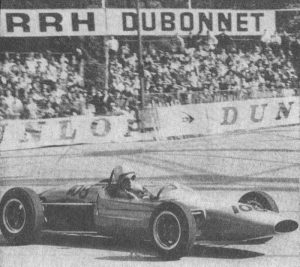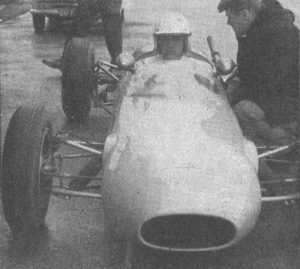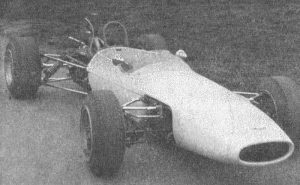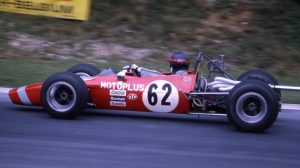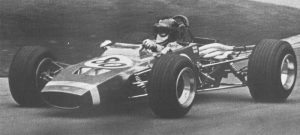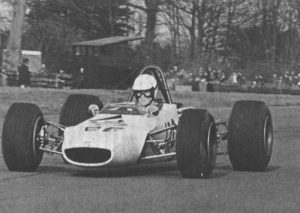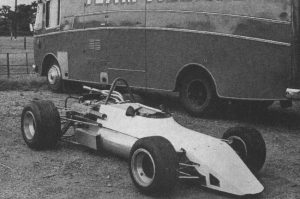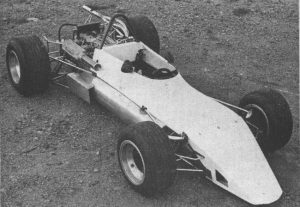Alexis
Alex Francis began building trials cars in 1953 and in 1959 he set up Alexis with Australian Bill Harris to start producing customer cars including a Formula Junior model. Harris had previously been responsible for the Flather 500cc F3 Special. For several years the team produced a number of increasingly sophisticated F Junior cars, the Mk5 in particular going very well. In fact a Mk5 was sold to DAF to be fitted with their Variomatic transmission and it was raced in F3 in 1964.
When Harris returned to Australia in 1965 Lotus 7 racer Allan Taylor took his place and Alexis became a serious racing car constructor, and Team Alexis ran cars in a number of formulae. Both F2 and F3 cars were constructed during the ’60s and some success was achieved, the highlight being Paul Hawkins winning the 1965 F2 Eifelrennen. The Jim Russell Driving School took 57 of the Alexis Formula Ford cars for its pupils to learn on in 1967-68, however by the start of the 1970s production began to slow down as other marques came to prominence and Alexis faded from the scene.
1964
The Mk6 was designed by Bill Harris for use both in F2 and F3 but both the chassis that were built were to F3 specification (The ’65 F2 car was built as the Mk7). The design was a continuation of the F Junior line and the results weren’t too encouraging with a best of 6th in a race at Monza for John Ampt.
In addition a number of Mk 4 and 5 F Junior cars were converted to F3 spec, notably the MK5 that was run by the works in early season races. The Mk4 was the 1962 F Junior car, featuring disc brakes and a Hewland gear box for the first time. A single Mk5 was produced in 1963, similar but smaller than the Mk4 it also featured fibreglass bodywork. This was the car that would be sold to DAF.
1965
Another Bill Harris design and again it was intended as a dual-purpose F2/F3 design, the Mk8 used a shorter spaceframe than the Mk6, it finished in front of the driveshafts. Modified suspension with new uprights and revised Mk 6 bodywork was used. Three cars were built but again results were disappointing with a best of 4th and 6th in the same race at Monza for Maglia and Blokdyk.
1966
Allan Taylor was the new designer for the Mk9, it was apparently a stronger car than the Mk8 and used a further modified bodywork but it still showed no signs of competitiveness. Unhappy with the customer Cosworth MAE engines available Alexis began to develop their own but with no sign of any improvement.
1967
For the first time for several years Alexis didn’t produce a new model.
1968
Introduced part way through the season the Mk12 was once again a conventional design using a modern type space frame chassis with typical Alexis suspension employing wide based wishbones at the front, the team continued to persevere with their own version of the MAE engine. Three cars were produced but it was another year without a breakthrough, the best finish was a seventh at Chimay for Terry Ogilvie-Hardy who used a Novamotor-headed Cosworth engine.
1969
Once again it was a mid-season debut for the latest Alexis F3, the Mk17, the chassis is sometimes called a Mk16, this would seem to be an early designation with the Mk17 intended to be a F2/F5000 car that was never built. It had a more sophisticated tubular steel chassis than the Mk12 and it featured a slightly wedge-shaped body. On occasions it showed some promise although once again the home brewed engines seemed to lack in the horsepower department. Ken Crook did a lot of the driving but numerous niggling problems prevented any real progress being made.
Transmission: Hewland Mk6 4-speed
Brakes: Girling 10.25 in diameter discs front and rear.
Suspension: Front, wishbones and coil springs: rear lower wishbones, top links, twin radius rods and coil springs.
Dimensions: wheelbase 89 in. track front 54.5 in. rear 55.25 in.
Wheels: 13 in. diameter front and rear.
1970
The Mk17 was used again in 1970 but despite the switch to a Holbay engine in the works car results weren’t noticeably better with Ken Bailey managing a best of sixth at Mallory Park early in the year.
1971
Based on the previous year’s Mk17 F3 chassis, the Mk 20 had revised front suspension, side radiators and a wedge nose that gave a very neat overall appearance, a Vegantune engine was fitted. Sadly it seemed that very little development work was carried out and this was the last F3 Alexis to be seen.
DRIVERS-
1964
Mk6
John Ampt, George Smith.
Mk5
John Ampt.
?
Bruno Deserti, Paul Hawkins, Roy Pike, George Smith, Henk van Zalinge.
1965
Mk8
Trevor Blokdyk, Jacques Maglia.
Mk6
Allan Taylor.
Mk4
George Smith.
?
Manfred Zeller.
1966
Mk8
Allan Taylor.
Mk6
Allan Taylor.
Mk5
Terry Ogilvie-Hardy.
Mk4
George Smith.
1967
Mk3
George Smith.
Mk6
Allan Taylor, Peter Watts.
Mk5
Terry Ogilvie-Hardy.
?
Dave Walker
1968 Mk12
David Cole, Trevor Fowler, Terry Ogilvie-Hardy.
1969 Mk17
David Cole, Ken Crook, Dick Barker.
1970 Mk17
Ken Bailey.
1971 Mk20
Alan McCully, Allan Taylor.
